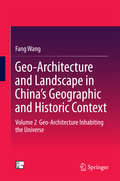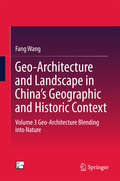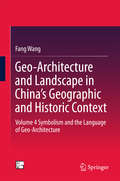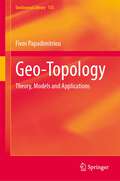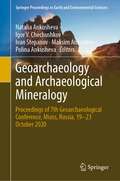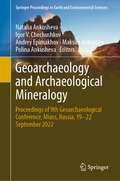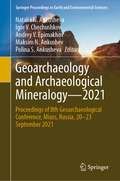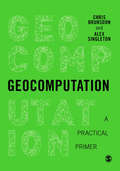- Table View
- List View
Geo-Architecture and Landscape in China’s Geographic and Historic Context: Volume 2 Geo-Architecture Inhabiting the Universe
by Fang WangThis book approaches the concept of geo-architecture from the perspective of functions of architectures by analyzing the cases of traditional Chinese houses and tombs as well as palaces and places of worship. Houses and tombs, the ‘Yang’ dwellings and ‘Yin’ dwellings of human beings in traditional Chinese interpretation, are the two types of architectures that reveal the wisdom with which different ethnic groups adapted to different geographic environments at different times throughout the long history. Palaces are connected with various religious architectures throughout the Chinese history. The connection between imperial power and religion, along with its geographic and cultural connotations, are implicated in the pattern and layout of religious and imperial architectures. This book is the second of a 4-volume book series. The series develops the innovative concept of “geo-architecture” by exploring the myriad influences of natural, human and historical factors upon architecture. These influences are considered in three categories, namely, interaction between architecture and nature, interaction between architecture and its human users and change in architecture over time--each category serves as a lens. Augmenting these lenses is the Time-Person-Place concept applied different geographic. The analysis ultimately focuses on two aspects: geographic influence on architecture and architectural response to geography. The over 1000 pictures of case architectures enriches the study with stunning and unique visual angles."This unprecedented work will be a unique and valuable contribution to the literature. Integrating as it does the disciplines of architecture, landscape architecture, and geography, Wang Fang’s voice is original, compelling, and will be much appreciated by English-speaking readers (and inside China, too, I can only imagine.)"Stephen M Ervin Assistant Dean Graduate School of Design, Harvard University July 2nd, 2013"One reason for why there would be interest is because her research would fill some significant gaps in the literature.What is novel about Dr. Wang’s series is that she further extends this intellectual project of looking at Chinese architecture through Chinese eyes, by taking it one provocative step further."Annette M. Kim Associate Professor Department of Urban Studies and Planning, M.I.T. July 1st, 2013
Geo-Architecture and Landscape in China’s Geographic and Historic Context: Volume 3 Geo-Architecture Blending into Nature
by Fang WangThis book explores the concept of geo-architecture by analyzing the ways architectures are related to the local geography, including mingling or contrasting with surrounding landscape, adapting to mountainous or aquatic terrain, and selection of construction materials. Architectures build with such skillfully contrived strategies and techniques have become live exhibit of folk customs and served to record in profound detail the long history of mankind’s recognition of nature. The combined effect is such that the architecture grows out of the surrounding natural and human environment. This book is the third of a 4-volume book series. The series develops the innovative concept of “geo-architecture” by exploring the myriad influences of natural, human and historical factors upon architecture. These influences are considered in three categories, namely, interaction between architecture and nature, interaction between architecture and its human users and change in architecture over time--each category serves as a lens. Augmenting these lenses is the Time-Person-Place concept applied different geographic. The analysis ultimately focuses on two aspects: geographic influence on architecture and architectural response to geography. The over 1000 pictures of case architectures enriches the study with stunning and unique visual angles."This unprecedented work will be a unique and valuable contribution to the literature. Integrating as it does the disciplines of architecture, landscape architecture, and geography, Wang Fang’s voice is original, compelling, and will be much appreciated by English-speaking readers (and inside China, too, I can only imagine.)"Stephen M Ervin Assistant Dean Graduate School of Design, Harvard University July 2nd, 2013"One reason for why there would be interest is because her research would fill some significant gaps in the literature.What is novel about Dr. Wang’s series is that she further extends this intellectual project of looking at Chinese architecture through Chinese eyes, by taking it one provocative step further."Annette M. Kim Associate Professor Department of Urban Studies and Planning, M.I.T. July 1st, 2013
Geo-Architecture and Landscape in China’s Geographic and Historic Context: Volume 4 Symbolism and the Language of Geo-Architecture
by Fang WangThis book approaches the concept of geo-architecture by analyzing the symbolic characters of architectures. It proves that the relationship between architecture and geography is not merely an embodiment of physical and functional demands but rather a formal expression of the materialization of culture. After analyzing the vast number of villages, groups of buildings and individual buildings the forms of which closely resemble the forms of the Bagua (symbol of the Eight Trigrams), Taichi, animals and plants, this book finds that this kind of symbolism creatively places living and working places within the natural geographic environment and, by seeking a relationship between architecture and its surrounding environment, comes to express people’s hopes and dreams, evolving slowly to take on certain cultural connotations. This book is the fourth of a 4-volume book series. The series develops the innovative concept of “geo-architecture” by exploring the myriad influences of natural, human and historical factors upon architecture. These influences are considered in three categories, namely, interaction between architecture and nature, interaction between architecture and its human users and change in architecture over time--each category serves as a lens. Augmenting these lenses is the Time-Person-Place concept applied different geographic. The analysis ultimately focuses on two aspects: geographic influence on architecture and architectural response to geography. The over 1000 pictures of case architectures enriches the study with stunning and unique visual angles."This unprecedented work will be a unique and valuable contribution to the literature. Integrating as it does the disciplines of architecture, landscape architecture, and geography, Wang Fang’s voice is original, compelling, and will be much appreciated by English-speaking readers (and inside China, too, I can only imagine.)"Stephen M Ervin Assistant Dean Graduate School of Design, Harvard University July 2nd, 2013"One reason for why there would be interest is because her research would fill some significant gaps in the literature.What is novel about Dr. Wang’s series is that she further extends this intellectual project of looking at Chinese architecture through Chinese eyes, by taking it one provocative step further."Annette M. Kim Associate Professor Department of Urban Studies and Planning, M.I.T. July 1st, 2013
The Geo-Doc: Geomedia, Documentary Film, and Social Change (Palgrave Studies in Media and Environmental Communication)
by Mark TerryThis book introduces a new form of documentary film: the Geo-Doc, designed to maximize the influential power of the documentary film as an agent of social change. By combining the proven methods and approaches as evidenced through historical, theoretical, digital, and ecocritical investigations with the unique affordances of Geographic Information System technology, a dynamic new documentary form emerges, one tested in the field with the United Nations. This book begins with an overview of the history of the documentary film with attention given to how it evolved as an instrument of social change. It examines theories surrounding mobilizing the documentary film as a communication tool between filmmakers and policymakers. Ecocinema and its semiotic storytelling techniques are also explored for their unique approaches in audience engagement. The proven methods identified throughout the book are combined with the spatial and temporal affordances provided by GIS technology to create the Geo-Doc, a new tool for the activist documentarian.
Geo-economic Perspectives in the Global Environment
by Faisal Ahmed Arbuda SharmaThe Covid-19 pandemic brought about significant changes in the world order. It not only reshaped the global geopolitical architecture but also created newer challenges and opportunities for international trade and businesses. This book deliberates on these new global realities through a multidisciplinary perspective. It delves into various key issues pertaining to finance, infrastructure, policy, geostrategy, and entrepreneurship in the Indian context. The volume discusses themes such as geostrategic shifts and their impact on the Indo-Pacific region, the effects of Covid-19 on international and economic security, India-China bilateral ties, FDI spill over on domestic firms, entrepreneurship education in India, and the Thai Canal project. Rich in insights on various geo-economic perspectives that continue to shape the global business environment, the book will be useful for students and scholars of sociology, business management, business economics, international trade, geopolitics, international relations, political sociology, and political studies. It will serve as a useful reference for academics, researchers, think tanks, industry professionals, and policymakers.
Geo-economic Perspectives in the Global Environment
by Faisal Ahmed Arbuda SharmaThe Covid-19 pandemic brought about significant changes in the world order. It not only reshaped the global geopolitical architecture but also created newer challenges and opportunities for international trade and businesses. This book deliberates on these new global realities through a multidisciplinary perspective. It delves into various key issues pertaining to finance, infrastructure, policy, geostrategy, and entrepreneurship in the Indian context. The volume discusses themes such as geostrategic shifts and their impact on the Indo-Pacific region, the effects of Covid-19 on international and economic security, India-China bilateral ties, FDI spill over on domestic firms, entrepreneurship education in India, and the Thai Canal project. Rich in insights on various geo-economic perspectives that continue to shape the global business environment, the book will be useful for students and scholars of sociology, business management, business economics, international trade, geopolitics, international relations, political sociology, and political studies. It will serve as a useful reference for academics, researchers, think tanks, industry professionals, and policymakers.
Geo-Politics in Northeast Asia (Politics in Asia)
by Akihiro Iwashita Yong-Chool Ha Edward BoyleGeo-Politics in Northeast Asia focuses on the dynamics of Northeast Asia as a region. The chapters in this book offer a nuanced approach for understanding the geo-politics of this strategically critical area of the world. Focusing on China, Japan, Russia, and the Koreas, as well as the involvement of the United States, the contributors to the volume offer a timely and critical analysis of Northeast Asia. They collectively emphasize the different scales at which the region holds significance, and particularly note how the region is often granted significance by local political forces as well as national interests. Borderlands and sub-regions are especially important in this perspective, and the contributors show both how regionalism influences the people living in these areas and how they in turn shape the political priorities of states. At the same time, the worsening of relations between Japan and the Koreas and the increasing assertiveness of both China and Russia make it essential to understand the dynamics of the region, as well as how they have changed during and following the Trump era. Geo-Politics in Northeast Asia is essential reading for students and scholars of Political Geography, International Relations and Strategic Studies, as well as for those with a research focus on Northeast Asia, or the wider Asia-Pacific and Indo-Pacific regions.
Geo-Politics in Northeast Asia (Politics in Asia)
by Akihiro Iwashita Yong-Chool Ha Edward BoyleGeo-Politics in Northeast Asia focuses on the dynamics of Northeast Asia as a region. The chapters in this book offer a nuanced approach for understanding the geo-politics of this strategically critical area of the world. Focusing on China, Japan, Russia, and the Koreas, as well as the involvement of the United States, the contributors to the volume offer a timely and critical analysis of Northeast Asia. They collectively emphasize the different scales at which the region holds significance, and particularly note how the region is often granted significance by local political forces as well as national interests. Borderlands and sub-regions are especially important in this perspective, and the contributors show both how regionalism influences the people living in these areas and how they in turn shape the political priorities of states. At the same time, the worsening of relations between Japan and the Koreas and the increasing assertiveness of both China and Russia make it essential to understand the dynamics of the region, as well as how they have changed during and following the Trump era. Geo-Politics in Northeast Asia is essential reading for students and scholars of Political Geography, International Relations and Strategic Studies, as well as for those with a research focus on Northeast Asia, or the wider Asia-Pacific and Indo-Pacific regions.
Geo Spaces of Communication Research (Studies in Media and Communications #26)
by Laura Robinson, Shelia R. Cotten and Jeremy SchulzSponsored by the Brazil-U.S. Colloquium on Communication Studies of the Brazilian Society for Interdisciplinary Studies in Communication and the Communication, Information Technologies, and Media Sociology Section of the American Sociological Association (CITAMS), this volume of Studies in Media and Communications is entitled Geo Spaces of Communication Research. The volume brings together scholars from across the Americas to address the complex evolution of political and policy media spaces as they are studied from a range of perspectives. The volume probes how media and digital tech are transforming how individuals, groups, and societies communicate within and across social worlds, as well as how emergent methodologies are evolving to keep pace with these phenomena.
Geo Spaces of Communication Research (Studies in Media and Communications #26)
by Laura Robinson Katia Moles Sonia Virgínia Moreira Jeremy SchulzSponsored by the Brazil-U.S. Colloquium on Communication Studies of the Brazilian Society for Interdisciplinary Studies in Communication and the Communication, Information Technologies, and Media Sociology Section of the American Sociological Association (CITAMS), this volume of Studies in Media and Communications is entitled Geo Spaces of Communication Research. The volume brings together scholars from across the Americas to address the complex evolution of political and policy media spaces as they are studied from a range of perspectives. The volume probes how media and digital tech are transforming how individuals, groups, and societies communicate within and across social worlds, as well as how emergent methodologies are evolving to keep pace with these phenomena.
Geo-Spatiality in Asian and Oceanic Literature and Culture: Worlding Asia in the Anthropocene (Geocriticism and Spatial Literary Studies)
by Shiuhhuah Serena Chou Soyoung Kim Rob Sean WilsonThis collection opens the geospatiality of “Asia” into an environmental framework called "Oceania" and pushes this complex regional multiplicity towards modes of trans-local solidarity, planetary consciousness, multi-sited decentering, and world belonging. At the transdisciplinary core of this “worlding” process lies the multiple spatial and temporal dynamics of an environmental eco-poetics, articulated via thinking and creating both with and beyond the Pacific and Asia imaginary.
Geo-Topology: Theory, Models and Applications (GeoJournal Library #133)
by Fivos PapadimitriouGeo-Topology is an exploration of the depth and breadth of the relationships between Geography and Topology, with applications ranging from Landscape Geography to Social Geography and from Spatial Analysis to Geospatial Technologies. It shows how topics of geographical research (landscapes, borders, spatial social relationships etc) can be examined by using mathematical concepts and methods of Topology, exposing the realm of geo-topological modelling and visualization through Point-Set Topology, Knot Theory, Reeb graphs, Topological Surfaces (i.e. Möbius bands and Klein bottles), Differential Topology, Network Analysis, Combinatorial Topology, Braid Theory and Ultrametric Topology. Besides geographers, this book is a trove of new ideas for landscape ecologists, mathematicians, data scientists, sociologists, psychologists, anthropologists and educators. Geo-Topology is a systematic introduction to topological thinking in Geography, also by highlighting the significance of Topology for Geographical Education, as well as for the Philosophy and Epistemology of Geography.
geo@web: Medium, Räumlichkeit und geographische Bildung
by Inga Gryl Tobias Nehrdich Robert VoglerGeomedien haben im Zuge der aktuellen Konstitution des Internets und der Nutzung mobiler Endgeräte nahezu Omnipräsenz im Alltag erlangt. Sie binden das soziale Web enger in lebensweltliche Kontexte ein, indem sie Information und Bedeutung an sinnlich-leiblich erfahrbare Orte knüpfen. Zusammen mit einer Pluralisierung von Deutungen durch die aktuelle Prosumentenkultur im Internet führt dies zu einer Transformation der Auffassungen von Räumlichkeit. Dies hat Konsequenzen sowohl für alltägliches räumliches Handeln als auch für raumbezogene Verstehensprozesse und damit für geographische Bildung. Die Autoren zeigen die Vielfalt der sozialen Implikationen des Zusammentreffens von geo@web auf und bieten erste Wege zur Orientierung in diesem neuen, komplexen Feld der Forschung und Praxis an.
Geoarchaeology and Archaeological Mineralogy: Proceedings of 7th Geoarchaeological Conference, Miass, Russia, 19–23 October 2020 (Springer Proceedings in Earth and Environmental Sciences)
by Natalia Ankusheva Maksim Ankushev Igor V. Chechushkov Ivan Stepanov Polina AnkushevaThis book of Springer Proceedings in Geoarchaeology and Archaeological Mineralogy contains selected papers presented at the 7th Geoarchaeology Conference, which took place during October 19–23, 2020, at the South Urals Federal Research Center, Ural Branch of Russian Academy of Sciences, Miass, Russia. The Proceedings combine studies in archeometry, geoarchaeology, and ancient North Eurasian technologies, including paleometallurgy, stone tools investigation, past exploitation of geological resources, bioarchaeology, residue analysis, pottery, and lithics studies. This book also specializes in various non-organic materials, rocks, minerals, ores, and metals, especially copper and metallurgical slags. Many types of research also use modern analytical methods of isotopic, chemical, and mineralogical analysis to address the composition and structure of ancient materials and the technological practices of past human populations of modern Russia, Ukraine, Turkmenistan, Tajikistan, and Mongolia. This book is intended for archaeologists, historians, museum workers, and geologists, as well as students, researchers from other disciplines, and the general public interested in the interdisciplinary research in the field of archaeology and archaeological materials, strategies and techniques of past quarrying, mining, metallurgy and lithic technologies at different chronological periods in Eurasian steppe and adjacent forest zone.
Geoarchaeology and Archaeological Mineralogy: Proceedings of 9th Geoarchaeological Conference, Miass, Russia, 19–22 September 2022 (Springer Proceedings in Earth and Environmental Sciences)
by Natalia Ankusheva Igor V. Chechushkov Andrey Epimakhov Maksim Ankushev Polina AnkushevaThe volume of Springer Proceedings in Geoarchaeology and Archaeological Mineralogy contains selected papers presented at the 9th Geoarchaeology Conference, which took place during September 19–22, 2022, at the South Urals Federal Research Center, the Ural Branch of the Russian Academy of Sciences, Miass, Russia. The Proceedings unite studies in the fields of archeometry, geoarchaeology, and ancient technologies, based on cases from northern Eurasia, and include archaeometallurgy, stone tools investigation, exploitation of geological resources in the past, bioarchaeology, residue analysis, pottery and lithics investigation, use of the GIS in archaeology. A study of non-organic materials, rocks, minerals, ores, metals, metallurgical slags is a special focus of the book. Many papers also use modern analytical methods of isotopic, chemical, and mineralogical analysis to study the composition and structure of ancient materials and the technological practices of past human populations of Modern Russia, Ukraine, Turkmenistan, Tajikistan, and Mongolia. The volume is intended for archaeologists, historians, museum workers, and geologists, as well as students, researchers from other disciplines, and the general public interested in the interdisciplinary research in the field of archaeology and archaeological materials, strategies and techniques of past quarrying, mining, metallurgy and lithic technologies at different chronological periods in Eurasian steppe and adjacent forest zone.
Geoarchaeology and Archaeological Mineralogy: Proceedings of 6th Geoarchaeological Conference, Miass, Russia, 16–19 September 2019 (Springer Proceedings in Earth and Environmental Sciences)
by Anatoly Yuminov Natalia Ankusheva Maksim Ankushev Elizaveta Zaykova Dmitry ArtemyevThis book presents general problems in geoarchaeology, and discusses geophysical solutions, X-ray fluorescence spectrometry applications, X-ray and isotope analyses and GIS technologies. It also examines practical reconstructions of technological processes used in ancient time, and investigates the use of minerals and rocks by ancient societies in the territories of modern Russia, Ukraine, Turkmenistan, and Tajikistan, as well as the characteristics of ores, metallurgical slags and data on the composition and impurities of archaeological metals. Intended for archaeologists, historians, museum workers and geologists studying noble metals and copper, the book is also a useful resource for students, graduate students, experts and anyone interested in the use of various minerals at different stages of humanity’s development.
Geoarchaeology and Archaeological Mineralogy—2021: Proceedings of 8th Geoarchaeological Conference, Miass, Russia, 20–23 September 2021 (Springer Proceedings in Earth and Environmental Sciences)
by Natalia N. Ankusheva Igor V. Chechushkov Andrey V. Epimakhov Maksim N. Ankushev Polina S. AnkushevaThis book unites studies in the fields of archaeometry, geoarchaeology, and ancient technologies, based on cases from northern Eurasia, and includes archaeometallurgy, stone tools investigation, exploitation of geological resources in the past, bioarchaeology, residue analysis, pottery and lithics investigation, and use of the GIS in archaeology. The book of Springer Proceedings in Geoarchaeology and Archaeological Mineralogy contains selected papers presented at the 8th Geoarchaeology Conference, which took place during September 20–23, 2021, at the South Urals Federal Research Center, the Ural Branch of the Russian Academy of Sciences, Miass, Russia. A study of non-organic materials, rocks, minerals, ores, metals and metallurgical slags is a special focus of the book. Many papers also use modern analytical methods of isotopic, chemical, and mineralogical analysis to study the composition and structure of ancient materials and the technological practices of past human populations of Modern Russia, Ukraine, Turkmenistan, Tajikistan and Mongolia. The book is intended for archaeologists, historians, museum workers and geologists, as well as students, researchers from other disciplines and the general public interested in the interdisciplinary research in the field of archaeology and archaeological materials, strategies and techniques of past quarrying, mining, metallurgy and lithic technologies at different chronological periods in Eurasian steppe and adjacent forest zone.
Geoarchaeology in Action: Studies in Soil Micromorphology and Landscape Evolution
by Charles FrenchGeoarchaeology in Action provides much-needed 'hands on' methodologies to assist anyone conducting or studying geoarchaeological investigations on sites and in landscapes, irrespective of date, place and environment.The book sets out the essential features of geoarchaeological practice and geomorphological processes, and is deliberately aimed at the archaeologist as practitioner in the field. It explains the basics - what can be expected, what approaches may be taken, and what outcomes might be forthcoming, and asks what we can reasonably expect a micromorphological approach to archaeological contexts, data and problems to tell us.The twelve case studies are taken from Britain, Europe and the Near East. They illustrate how past landscape change can be discovered and deciphered whether you are primarily a digger, environmentalist or soil micromorphologist.Based on the author's extensive experience of investigating buried and eroded landscapes, the book develops new ways of looking at conventional models of landscape change. With an extensive glossary, bibliography and more than 100 illustrations it will be an essential text and reference tool for students, academics and professionals.
Geoarchaeology in Action: Studies in Soil Micromorphology and Landscape Evolution
by Charles FrenchGeoarchaeology in Action provides much-needed 'hands on' methodologies to assist anyone conducting or studying geoarchaeological investigations on sites and in landscapes, irrespective of date, place and environment.The book sets out the essential features of geoarchaeological practice and geomorphological processes, and is deliberately aimed at the archaeologist as practitioner in the field. It explains the basics - what can be expected, what approaches may be taken, and what outcomes might be forthcoming, and asks what we can reasonably expect a micromorphological approach to archaeological contexts, data and problems to tell us.The twelve case studies are taken from Britain, Europe and the Near East. They illustrate how past landscape change can be discovered and deciphered whether you are primarily a digger, environmentalist or soil micromorphologist.Based on the author's extensive experience of investigating buried and eroded landscapes, the book develops new ways of looking at conventional models of landscape change. With an extensive glossary, bibliography and more than 100 illustrations it will be an essential text and reference tool for students, academics and professionals.
Geoarchäologie
by Christian Stolz Christopher E. MillerDas erste deutschsprachige Lehrbuch der Geoarchäologie bietet einen hervorragenden Einstieg in eine vielfältige Disziplin, die der Archäologie wie auch der Physischen Geographie und anderen Geowissenschaften zugewandt ist. Der Überblick über die breite methodische Vielfalt der Geoarchäologie macht dieses Buch zum verlässlichen Nachschlagewerk für Studierende, Forschende und Praktiker. Es gehört daher zum unverzichtbaren Handwerkszeug für alle, die sich mit umwelt- und kulturgeschichtlichen Fragen auseinandersetzen. Geoarchäologische Fragestellungen zählen zu den populärsten Themen innerhalb der beteiligten Fächer. Durch die Entschlüsselung von Geoarchiven mithilfe moderner Datierungs- und Analysemethoden und interdisziplinären Ansätzen gelingt es, frühere Kulturen innerhalb ihrer Umwelt zu verorten und vergangene Landschaften zu rekonstruieren. Gerade im Zeitalter des globalen Wandels erscheint es umso wichtiger, Zustände, Prozesse und Dynamiken der Vergangenheit zu verstehen, nicht zuletzt um daraus gewonnene Erkenntnisse auf zukünftige Entwicklungen anwenden zu können. Das Buch wurde von Wissenschaftlerinnen und Wissenschaftlern von über 30 verschiedenen Universitätsinstituten, Behörden und Forschungseinrichtungen erarbeitet. Die Herausgeber sind Sprecher des 2004 gegründeten Arbeitskreises Geoarchäologie. Ihre über 70 Mitautorinnen und Mitautoren gehören zu den kundigsten Fachleuten ihrer Themen im deutschsprachigen Raum und darüber hinaus.
Geochemical Biomarkers
by T.F. Yen J.M. MoldowanFirst Published in 1988. Routledge is an imprint of Taylor & Francis, an informa company.
Geochemical Biomarkers
by T.F. Yen J.M. MoldowanFirst Published in 1988. Routledge is an imprint of Taylor & Francis, an informa company.
Geochemical Evidence for Long-Distance Exchange (Scientific Archaeology for the Third Millennium)
by Michael D. GlascockStudies of prehistoric exchange of goods provide information about the types of economic interaction, social organization, or political structures in which prehistoric peoples were engaged. Long-distance exchange is a special situation where the materials exchanged crossed significant boundaries, whether they were geographic, social, political, or otherwise. By examining the types and quantities of goods exchanged, along with the directions and distances they moved, archaeologists are able to examine the dynamic properties of exchange systems, i.e., how they operate and why they undergo change.The purpose of this volume is to present a number of case studies of long-distance exchange from around the world which demonstrate the use of geochemical analysis of artifacts to find evidence of exchange. More important than the use of analytical technique employed or the types of artifacts studied are the interpretations themselves which illustrate that exchange studies are maturing and helping archaeologists to develop more accurate models of exchange.
Geocomputation: A Practical Primer (PDF)
by Alex David Singleton Chris BrunsdonGeocomputation is the use of software and computing power to solve complex spatial problems. It is gaining increasing importance in the era of the ‘big data’ revolution, of ‘smart cities’, of crowdsourced data, and of associated applications for viewing and managing data geographically - like Google Maps. This student focused book: Provides a selection of practical examples of geocomputational techniques and ‘hot topics’ written by world leading practitioners. Integrates supporting materials in each chapter, such as code and data, enabling readers to work through the examples themselves. Chapters provide highly applied and practical discussions of: Visualisation and exploratory spatial data analysis Space time modelling Spatial algorithms Spatial regression and statistics Enabling interactions through the use of neogeography All chapters are uniform in design and each includes an introduction, case studies, conclusions - drawing together the generalities of the introduction and specific findings from the case study application – and guidance for further reading. This accessible text has been specifically designed for those readers who are new to Geocomputation as an area of research, showing how complex real-world problems can be solved through the integration of technology, data, and geocomputational methods. This is the applied primer for Geocomputation in the social sciences.
Geocomputation: A Practical Primer (Spatial Analytics and GIS)
by Alex David Singleton Chris BrunsdonGeocomputation is the use of software and computing power to solve complex spatial problems. It is gaining increasing importance in the era of the ‘big data’ revolution, of ‘smart cities’, of crowdsourced data, and of associated applications for viewing and managing data geographically - like Google Maps. This student focused book: Provides a selection of practical examples of geocomputational techniques and ‘hot topics’ written by world leading practitioners. Integrates supporting materials in each chapter, such as code and data, enabling readers to work through the examples themselves. Chapters provide highly applied and practical discussions of: Visualisation and exploratory spatial data analysis Space time modelling Spatial algorithms Spatial regression and statistics Enabling interactions through the use of neogeography All chapters are uniform in design and each includes an introduction, case studies, conclusions - drawing together the generalities of the introduction and specific findings from the case study application – and guidance for further reading. This accessible text has been specifically designed for those readers who are new to Geocomputation as an area of research, showing how complex real-world problems can be solved through the integration of technology, data, and geocomputational methods. This is the applied primer for Geocomputation in the social sciences.
